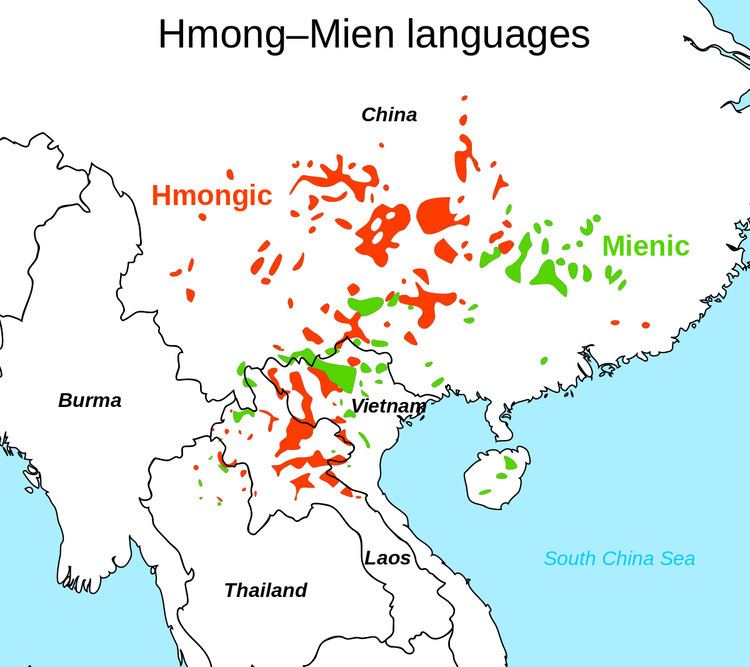ISO 639-5: hmx | Glottolog: hmon1336 | |
 | ||
Linguistic classification: One of the world's primary language families | ||
The Hmong–Mien (also known as Miao–Yao) languages are a language family of southern China and Southeast Asia. They are spoken in mountainous areas of southern China, including Guizhou, Hunan, Yunnan, Sichuan, Guangxi, and Hubei provinces, where its speakers have been relegated to being "hill people", whereas the Han Chinese have settled the more fertile river valleys. Within the last 300–400 years, the Hmong and some Mien people have migrated to Thailand, Laos, Vietnam, and Burma. As a result of the Indochina Wars, many Hmong speakers left Southeast Asia for Australia, the United States, French Guiana, and other countries.
Contents
Relationships
Hmong (Miao) and Mien (Yao) are closely related, but clearly distinct. For internal classifications, see Hmongic languages and Mienic languages. The largest differences are due to divergent developments in the phonology. The Hmongic languages appear to have kept the large set of initial consonants featured in the protolanguage but greatly reduced the distinctions in the syllable finals, in particular eliminating all medial glides and final consonants. The Mienic languages, on the other hand, have largely preserved syllable finals but reduced the number of initial consonants.
Early linguistic classifications placed the Hmong–Mien languages in the Sino-Tibetan family, where they remain in many Chinese classifications, but the current consensus among Western linguists is that they constitute a family of their own. The family is believed to have had its origins in central-southern China. The current area of greatest agreement is that the languages appeared in the region between the Yangtze and Mekong rivers, but there is reason to believe that speakers migrated there from further north with the expansion of the Han Chinese. The time of proto-Hmong-Mien has been estimated to be about 2500 BP (500 BC) by Sagart, Blench, and Sanchez-Mazas using traditional methods employing many lines of evidence, and about 4243 BP by the Automated Similarity Judgment Program (ASJP), an experimental algorithm for automatic generation of phonologically based phylogenies.
Paul K. Benedict, an American scholar, extended the Austric theory to include the Hmong–Mien languages. The hypothesis never received much acceptance for Hmong–Mien, however. Kosaka (2002) argued specifically for a Miao–Dai family.
Names
The Mandarin names for these languages are Miáo and Yáo.
In Vietnamese, the name for Hmong is "H'Mông", and the name Mien is "Dao".
Meo, Hmu, Mong, Hmao, and Hmong are local names for Miao, but since most Laotian refugees in the United States call themselves Hmong/Mong, this name has become better known in English than the others in recent decades. However, except for some scholars who prefer the word, the term 'Hmong/ Mong' is only used within certain Hmong/Miao language speaking communities in China, where the majority of the Miao speakers live. In Chinese, despite the fact that it was once a derogatory term, the word Miao (Chinese: 苗; the tone varies according to the dialect of Chinese) is now commonly used by members of all nationalities to refer to the language and the ethno-linguistic group.
The Chinese name Yao, on the other hand, is for the Yao nationality, which is a cultural rather than ethno-linguistic group. It includes peoples speaking Mien, Tai–Kadai, Yi, and Miao languages, the latter called Bùnǔ rather than Miáo when spoken by Yao. For this reason the ethnonym Mien may be preferred as less ambiguous.
Characteristics
Like many languages in southern China, the Hmong–Mien languages tend to be monosyllabic and syntactically analytic. They are some of the most highly tonal languages in the world: Longmo and Zongdi Hmong have as many as twelve distinct tones. They are notable phonologically for the occurrence of voiceless sonorants and uvular consonants; otherwise their phonology is quite typical of the region.
They are SVO in word order but are not as rigidly right-branching as the Tai–Kadai languages or most Mon–Khmer languages, since they have genitives and numerals before the noun like Chinese. They are extremely poor in adpositions: serial verb constructions replace most functions of adpositions in languages like English. For example, a construction translating as "be near" would be used where in English prepositions like "in" or "at" would be used.
Besides their tonality and lack of adpositions, another striking feature is the abundance of numeral classifiers and their use where other languages use definite articles or demonstratives to modify nouns.
